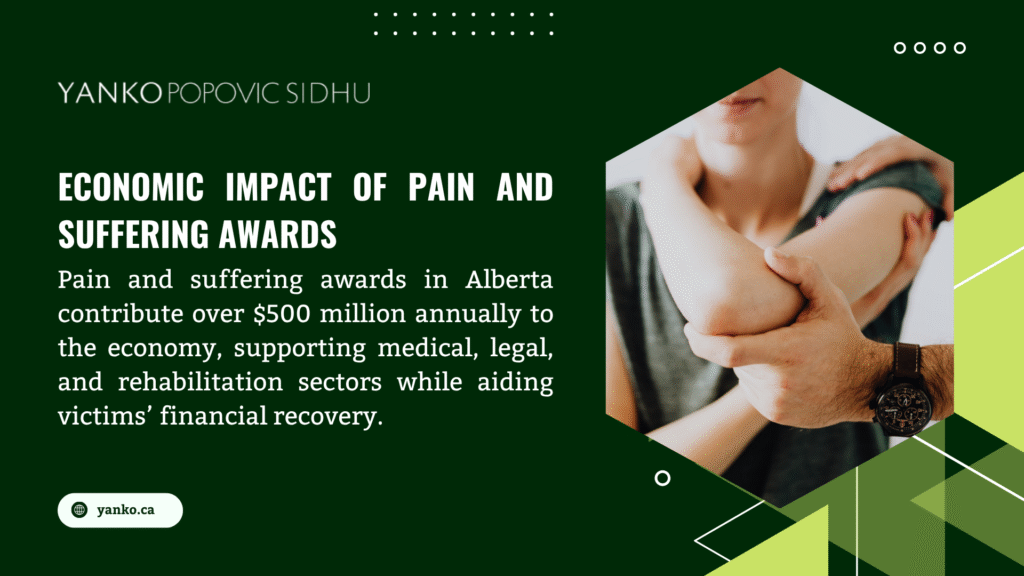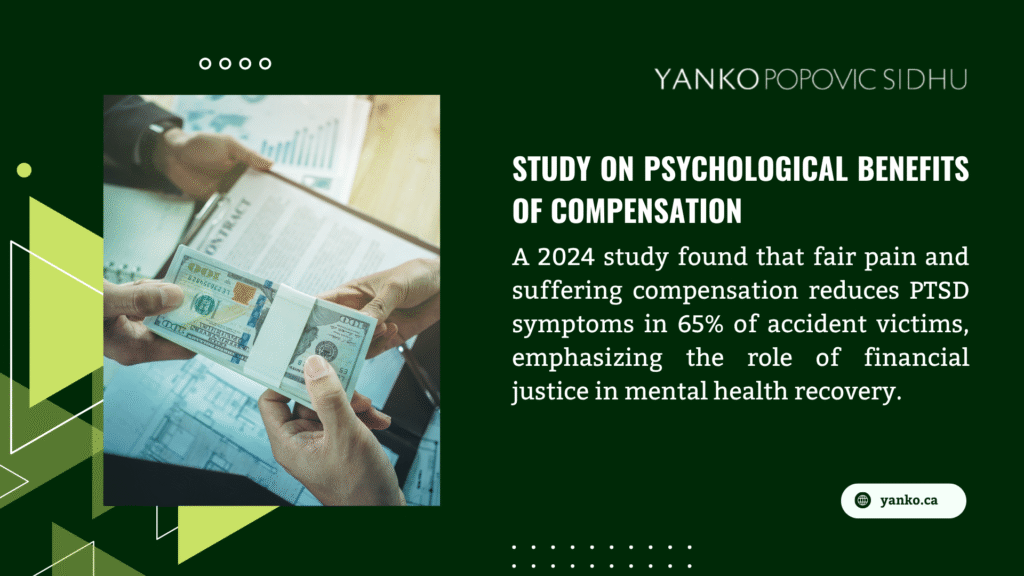Pain and suffering compensation in Alberta operates within a complex framework that balances individual justice with systematic fairness. With the 2025 minor injury cap set at $6,182 and the maximum general damages ceiling at approximately $465,000-$470,000, understanding pain and suffering compensation calculations has never been more critical for injury victims.
Current statistics reveal the substantial financial impact of pain and suffering compensation across Canada. The Supreme Court’s 1978 cap of $100,000, now adjusted to approximately $465,280 for inflation, affects thousands of injury cases annually. In Alberta specifically, Chadi & Company has recovered over $200 million for injury victims since 1991, with pain and suffering compensation representing a significant portion of these awards.
Recent data shows that 91% of legally represented claimants receive pain and suffering compensation compared to only 51% of self-represented victims—a stark difference that translates to hundreds of thousands of dollars in potential recovery. With Alberta preparing for its 2027 no-fault insurance transition that will eliminate most pain and suffering compensation opportunities, current victims have limited time to pursue full tort recovery under existing legislation.
The landscape of pain and suffering compensation continues evolving through judicial interpretation and legislative reform. Recent Alberta cases have seen awards ranging from $50,000-$60,000 for moderate soft tissue injuries to maximum cap amounts for catastrophic brain injuries and quadriplegia. Understanding these compensation ranges, calculation methodologies, and strategic approaches enables injury victims to pursue fair recovery for their intangible losses.
Understanding pain and suffering compensation in Alberta 2025
Pain and suffering compensation represents the monetary award for intangible losses that cannot be easily quantified through receipts or bills. Alberta law defines pain and suffering compensation as damages for physical discomfort, mental anguish, emotional distress, and loss of enjoyment of life resulting from injuries caused by another party’s negligence.
Unlike economic damages such as medical bills or lost wages, pain and suffering compensation addresses non-pecuniary losses that significantly impact victims’ quality of life. These damages serve to provide solace for intangible losses while acknowledging that no amount of money can truly restore what was lost through injury.
Current Pain and Suffering Compensation Limits in Alberta
Alberta’s pain and suffering compensation operates under two distinct cap systems that determine maximum recovery amounts. The minor injury cap, updated annually for inflation, currently stands at $6,182 for 2025, representing a 2% increase from 2024’s $6,061 limit.
| Compensation Category | 2025 Maximum Amount | Injury Types Covered | Annual Adjustment Method |
| Minor injury compensation | $6,182 | Sprains, strains, WAD I-II without serious impairment | 2% standardized escalator (changed from CPI) |
| Non-minor injury compensation | $20,000 – $470,000 | Injuries causing serious impairment | No specific cap below Supreme Court limit |
| Maximum general damages | $465,000 – $470,000 | Most catastrophic injuries (quadriplegia, severe TBI) | Annual inflation adjustment from 1978 $100,000 |
| Historical progression 2020-2025 | $5,296 → $6,182 | 16.7% total increase over 5 years | Reflects cumulative inflation impact |
Supreme Court Trilogy Impact
The foundation of Canadian pain and suffering compensation stems from the 1978 Supreme Court “Damages Trilogy” cases: Andrews v. Grand & Toy Alberta Ltd., Arnold v. Teno, and Thornton v. School District No. 57. These landmark decisions established the $100,000 cap for general damages, equivalent to approximately $465,280 in 2024 dollars after inflation adjustment.
Justice Brian Dickson’s reasoning in Andrews v. Grand & Toy established that unlimited pain and suffering compensation would create inconsistent and disproportionate awards. The Court determined that while plaintiffs should receive full compensation for economic losses, non-pecuniary damages serve only to make life more endurable rather than provide true compensation.
Serious Impairment Test
The critical distinction between minor and non-minor pain and suffering compensation depends on whether injuries cause “serious impairment.” Alberta law requires demonstrating that injuries prevent victims from performing essential tasks of employment, education, or daily life on an ongoing basis without substantial improvement prospects.
This test significantly impacts compensation potential, as injuries qualifying as minor remain capped at $6,182 regardless of actual pain levels or duration. Conversely, injuries meeting the serious impairment threshold access the full range of pain and suffering compensation up to the Supreme Court maximum.
Regional Comparison Data
Alberta’s pain and suffering compensation structure provides advantages compared to other Canadian jurisdictions. Unlike provinces with statutory deductibles—Ontario applies $19,877 or $39,754 deductibles to general damages—Alberta preserves full compensation recovery for legitimate claims.
Recent comparative analysis shows Alberta courts award pain and suffering compensation amounts consistent with other common law provinces, with typical ranges of $50,000-$60,000 for moderate soft tissue injuries that establish serious impairment. However, the 2027 transition to no-fault insurance will eliminate most pain and suffering compensation opportunities, making current recovery rights particularly valuable.

How pain and suffering compensation amounts are calculated
Pain and suffering compensation calculations in Alberta employ multiple methodologies that courts and insurance companies use to determine appropriate award amounts. Understanding these calculation methods enables injury victims to better evaluate settlement offers and prepare for negotiations.
The Multiplier Method
Insurance companies frequently employ the multiplier method for pain and suffering compensation calculations, beginning with total economic damages (medical bills, lost wages, property damage) and applying factors between 1.5 and 5.0 based on injury severity and impact.
| Injury Severity Level | Typical Multiplier Range | Economic Damages Example | Pain and Suffering Compensation |
| Minor injuries (cap applies) | 0.2 – 0.5 | $15,000 medical/lost wages | $3,000 – $6,182 (capped) |
| Moderate injuries | 1.5 – 2.5 | $25,000 economic damages | $37,500 – $62,500 |
| Serious injuries | 2.5 – 4.0 | $50,000 economic damages | $125,000 – $200,000 |
| Catastrophic injuries | 3.0 – 5.0 | $100,000+ economic damages | $300,000 – $470,000 (maximum) |
Per Diem Method
The per diem (daily rate) method assigns specific dollar amounts for each day victims experience pain and suffering compensation consequences. This approach requires establishing reasonable daily rates and proving pain duration through medical evidence and documentation.
Common daily rates range from $50-$500 depending on injury severity, with calculations extending from accident date through projected recovery periods. For permanent injuries, courts may apply daily rates through life expectancy calculations, though this method faces greater scrutiny from insurance companies and courts.
Comparative Case Analysis
Alberta courts rely heavily on comparative case analysis to determine appropriate pain and suffering compensation amounts. Legal professionals research similar injury cases, considering factors such as victim age, injury type, recovery duration, and functional limitations to establish reasonable compensation ranges.
Recent Alberta Court of Appeal analysis demonstrates this methodology in action. In one case involving moderate soft tissue injuries in a plaintiff’s 20s, the Court examined multiple precedent cases and determined that trial judge’s $35,000 award was “inordinately low,” establishing an appropriate range of $50,000-$60,000 based on recent comparable decisions.
Functional Capacity Assessment Impact
Pain and suffering compensation calculations increasingly incorporate functional capacity evaluations that objectively measure injury impacts on daily activities, work capabilities, and quality of life. These assessments provide quantifiable evidence supporting subjective pain claims.
Functional assessments examine specific limitations including lifting capacity, walking endurance, concentration abilities, and psychological functioning. Results directly influence pain and suffering compensation by demonstrating concrete ways injuries affect victims’ lives beyond medical treatment requirements.
Age and Life Impact Factors
Victim age significantly influences pain and suffering compensation calculations, as younger victims face potentially decades of ongoing limitations while older victims may have shorter life expectancy but greater adaptation challenges.
| Age Group | Compensation Considerations | Typical Impact on Awards |
| Children (0-18) | Entire life ahead, adaptation capacity | Higher multipliers for permanent injuries |
| Young adults (18-35) | Career establishment, family formation | Maximum impact for lifestyle limitations |
| Middle-aged (35-55) | Established activities, career peak | Significant awards for hobby/work limitations |
| Seniors (55+) | Adaptation challenges, shorter duration | Moderate awards reflecting life stage |
Medical Evidence Requirements
Strong pain and suffering compensation claims require comprehensive medical evidence documenting injury severity, treatment progression, and long-term prognosis. Objective diagnostic findings such as MRI abnormalities, X-ray fractures, or neurological test results carry more weight than subjective pain reports alone.
Treatment compliance patterns significantly affect compensation calculations. Consistent medical care demonstrates legitimate injury response, while gaps in treatment or missed appointments may suggest less severe pain levels. Insurance companies scrutinize treatment patterns to challenge pain and suffering compensation claims.
Current pain and suffering compensation award ranges by injury type
Pain and suffering compensation amounts vary significantly based on injury classification, severity, and long-term impact on victims’ lives. Understanding typical award ranges for different injury types helps victims set realistic expectations and evaluate settlement offers appropriately.
Minor Injury Compensation Ranges
Alberta’s Minor Injury Regulation caps pain and suffering compensation for sprains, strains, and whiplash-associated disorders (WAD I and II) that don’t cause serious impairment. The 2025 cap of $6,182 creates a ceiling regardless of actual pain levels or treatment duration.
| Minor Injury Type | Typical Compensation Range | Key Factors Affecting Amount | Documentation Requirements |
| WAD I (no immediate symptoms) | $1,500 – $4,000 | Delayed onset, symptom duration | Medical reports showing delayed presentation |
| WAD II (neck pain, limited motion) | $3,000 – $6,182 | Range restrictions, chronic pain development | Functional assessments, therapy records |
| Soft tissue sprains/strains | $2,000 – $6,182 | Location, severity, recovery time | Treatment progression, work restrictions |
| Minor psychological impacts | $1,000 – $4,000 | Related to physical injury only | Psychological evaluations, therapy notes |
Moderate Injury Pain and Suffering Compensation
Injuries exceeding the minor injury threshold through serious impairment open access to substantially higher pain and suffering compensation. These cases require demonstrating ongoing functional limitations that prevent normal activities.
| Moderate Injury Category | Compensation Range | Award Considerations |
| WAD III with neurological signs | $60,000 – $150,000 | Objective neurological deficits, functional testing |
| WAD IV with fracture/dislocation | $85,000 – $200,000 | Surgical requirements, permanent restrictions |
| Simple bone fractures | $25,000 – $75,000 | Location, healing complications, work impact |
| Complex/multiple fractures | $75,000 – $250,000 | Surgical complexity, ongoing limitations |
| Mild traumatic brain injury | $100,000 – $400,000 | Cognitive testing, personality changes |
| Herniated disc injuries | $50,000 – $200,000 | Surgical intervention, chronic pain levels |
Severe Injury Pain and Suffering Compensation
Serious permanent injuries that substantially alter victims’ lives command the highest pain and suffering compensation awards in Alberta. These cases often approach or reach the Supreme Court maximum cap.
Catastrophic Injury Examples with Actual Awards:
Recent Alberta cases demonstrate substantial pain and suffering compensation for catastrophic injuries. Brain injury cases have achieved awards exceeding $400,000, while spinal cord injuries reached $350,000-$450,000 depending on paralysis level and functional impact.
| Catastrophic Injury Type | Pain and Suffering Range | Recent Alberta Examples |
| Severe traumatic brain injury | $350,000 – $470,000 | Cognitive impairment, personality changes |
| Quadriplegia | $400,000 – $470,000 | Complete paralysis, total care dependence |
| Paraplegia | $300,000 – $400,000 | Lower body paralysis, mobility limitations |
| Severe burns (>20% body surface) | $250,000 – $400,000 | Scarring, psychological impact, functional limits |
| Multiple amputations | $300,000 – $450,000 | Prosthetic requirements, lifestyle changes |
| Vision loss (complete blindness) | $250,000 – $350,000 | Independence loss, career limitations |
Psychological Injury Pain and Suffering Compensation
Mental health impacts from accidents generate substantial pain and suffering compensation when properly documented through expert psychological evaluations and functional assessments.
Post-traumatic stress disorder, depression, anxiety, and cognitive changes require specialized evidence for successful compensation claims. Psychiatric expert evaluations, psychological testing, and pre-accident mental health baselines help establish accident-related changes requiring compensation.
| Psychological Condition | Compensation Range | Evidence Requirements |
| Severe PTSD | $75,000 – $200,000 | Psychiatric evaluation, functional testing |
| Major depression | $50,000 – $150,000 | Treatment records, medication requirements |
| Anxiety disorders | $25,000 – $100,000 | Symptom documentation, therapy compliance |
| Cognitive dysfunction | $100,000 – $300,000 | Neuropsychological testing, work impact |
Age-Related Award Variations
Victim age significantly influences pain and suffering compensation amounts, with younger victims typically receiving higher awards for identical injuries due to longer life expectancy and greater adaptation requirements.
Recent case analysis shows pain and suffering compensation awards for identical injuries can vary by 25-50% based solely on victim age, with courts considering factors such as pre-injury activity levels, career impacts, and long-term adaptation challenges.
Occupational Impact on Compensation
Professional occupation substantially affects pain and suffering compensation, particularly for injuries that prevent return to previous work or require significant career modifications. Construction workers facing physical limitations receive different compensation than office workers with similar injuries.
High-earning professionals like doctors, lawyers, or engineers who suffer career-limiting injuries may receive substantial pain and suffering compensation reflecting their lost ability to pursue challenging, rewarding careers. Conversely, retirees or those with limited career prospects typically receive lower awards reflecting reduced lifestyle impacts.

Legal strategies to maximize pain and suffering compensation
Successful pain and suffering compensation claims require strategic approach combining thorough documentation, expert evidence, and experienced legal representation. Understanding effective strategies enables injury victims to optimize their recovery potential while avoiding common pitfalls that reduce compensation awards.
Comprehensive Documentation Strategy
The foundation of strong pain and suffering compensation claims begins with systematic documentation from the accident scene through final resolution. Victims should maintain detailed records of all pain levels, functional limitations, and daily activity impacts throughout their recovery process.
| Documentation Category | Required Elements | Frequency | Strategic Value |
| Pain diary entries | Daily pain levels (1-10 scale), activity limitations | Daily for first 6 months, weekly thereafter | Establishes pain patterns, progression |
| Medical appointments | All treatment visits, prescribed medications | Every appointment documented | Demonstrates treatment compliance |
| Work impact records | Days missed, modified duties, colleague observations | Ongoing employment documentation | Shows economic and functional impacts |
| Activity limitations | Sports, hobbies, household tasks affected | Weekly documentation | Proves quality of life reductions |
| Photographic evidence | Visible injuries, assistive devices, lifestyle changes | Weekly initially, monthly ongoing | Visual demonstration of impacts |
Expert Witness Development
Pain and suffering compensation cases benefit significantly from expert witness testimony that provides objective validation of subjective pain claims. Strategic expert selection can substantially increase compensation awards through credible professional opinions.
Medical experts should include treating physicians who understand injury progression, independent medical examiners who provide objective assessments, and specialized professionals such as neurologists for brain injuries or orthopedic surgeons for musculoskeletal conditions.
Functional Capacity Evaluation Strategy
Independent functional capacity evaluations provide objective evidence supporting pain and suffering compensation claims by demonstrating specific ways injuries limit daily activities, work capabilities, and quality of life participation.
These evaluations examine lifting capacity, walking endurance, concentration abilities, and psychological functioning through standardized testing protocols. Results create compelling evidence for compensation negotiations by quantifying subjective limitations through objective measurements.
Treatment Compliance Optimization
Consistent medical treatment compliance strengthens pain and suffering compensation claims by demonstrating legitimate injury response and ongoing medical necessity. Gaps in treatment or missed appointments provide ammunition for insurance companies to argue injuries are less severe than claimed.
Victims should maintain regular medical appointments even when feeling better, as treatment gaps can undermine compensation claims. Alternative treatment options such as physiotherapy, chiropractic care, or psychological counseling should be pursued when recommended by medical professionals.
Specialized Legal Expertise
Experienced personal injury lawyers provide substantial advantages in pain and suffering compensation cases through specialized knowledge of valuation methodologies, expert witness networks, and negotiation strategies that maximize recovery potential.
Legal representation becomes particularly valuable for complex cases involving catastrophic injuries, disputed liability, or challenges to serious impairment determinations. Brain injury cases and spinal cord injuries require specialized expertise to achieve optimal compensation.
Pre-Litigation Settlement Strategy
Strategic pre-litigation negotiations can achieve substantial pain and suffering compensation without court proceedings through comprehensive demand packages that demonstrate case strength and compensation justification.
Effective demand letters include detailed medical evidence, expert opinions, functional assessments, and comparative case analysis supporting specific compensation amounts. Multiple rounds of structured negotiations gradually increase settlement values while maintaining professional relationships.
Trial Preparation Impact
Credible trial preparation significantly influences pain and suffering compensation settlement negotiations, as insurance companies offer higher settlements to avoid uncertain jury verdicts that could exceed their evaluation ranges.
Comprehensive trial preparation including expert witness retention, demonstrative evidence development, and jury research creates leverage that motivates insurance companies to offer fair compensation rather than risk potentially higher trial verdicts.
Timing Optimization Strategy
Optimal timing for pain and suffering compensation negotiations balances complete injury assessment against financial pressures and legal deadlines. Premature settlement before reaching Maximum Medical Improvement often results in inadequate compensation for conditions that worsen over time.
Strategic timing considerations include medical stability, treatment completion, expert report availability, and financial circumstances that may pressure early settlement acceptance. Professional legal guidance helps determine optimal negotiation timing for maximum compensation recovery.
Impact of Alberta’s 2027 no-fault transition on pain and suffering compensation
Alberta’s upcoming transition to a “Care-First” no-fault insurance system will fundamentally eliminate most pain and suffering compensation opportunities, making current tort rights particularly valuable for accident victims. Understanding these changes helps victims appreciate the urgency of pursuing claims under existing legislation.
Current vs. Future Pain and Suffering Rights
The existing tort system allows unlimited pain and suffering compensation (subject to caps) through litigation against at-fault drivers. Under the 2027 care-first system, pain and suffering compensation will be replaced by predetermined permanent impairment benefits administered by victims’ own insurers regardless of fault.
| Compensation Element | Current System (Until Dec 31, 2026) | Care-First System (From Jan 1, 2027) |
| Pain and suffering compensation | Up to $470,000 for catastrophic injuries | Eliminated – replaced by permanent impairment benefits |
| Minor injury compensation | $6,182 cap for non-serious impairment | Standardized benefit schedule amounts |
| Litigation rights | Full right to sue at-fault drivers | Severely restricted – limited exceptions only |
| Individual assessment | Personalized evaluation of unique circumstances | Standardized benefits based on impairment schedules |
| Recovery timeline | 1-3 years through negotiation/litigation | Weeks to months for benefit determination |
Permanent Impairment Benefits Structure
The care-first system will replace traditional pain and suffering compensation with permanent impairment benefits similar to Workers’ Compensation models. These benefits provide predetermined amounts based on standardized impairment ratings rather than individualized assessments of pain and suffering impacts.
While specific benefit amounts await regulatory development, similar systems in other jurisdictions typically provide 10-30% of traditional pain and suffering compensation amounts. Saskatchewan’s no-fault system, for example, offers permanent impairment benefits ranging from $5,000-$200,000 compared to potential tort awards of $50,000-$450,000 for similar injuries.
Limited Litigation Exceptions
The care-first system restricts pain and suffering compensation litigation to specific circumstances including Criminal Code convictions, prescribed Traffic Safety Act offenses, and claims against third parties like manufacturers or municipalities.
These exceptions preserve limited tort rights but eliminate the vast majority of current pain and suffering compensation opportunities. General damages for pain and suffering will be reduced by any permanent impairment benefits paid, while joint and several liability will be eliminated in favor of proportionate fault-based damages.
Strategic Implications for Current Victims
Accident victims injured before January 1, 2027, maintain full tort rights including unrestricted pain and suffering compensation opportunities. These victims represent the final generation with complete access to traditional general damages and comprehensive litigation rights.
The 21-month implementation timeline creates urgency for potential claims while highlighting the substantial compensation differences between current and future systems. Industry estimates suggest victims under the care-first system will receive 40-60% less total compensation compared to current tort recovery opportunities.
Enhanced Medical Benefits Trade-Off
The care-first system promises enhanced medical benefits with unlimited coverage for necessary treatment throughout victims’ lifetimes, compared to current $50,000 two-year limitations. Income replacement will increase to 90% of net income up to $120,000 gross annually until age 65.
However, these enhanced benefits eliminate pain and suffering compensation that often represents 30-50% of total injury awards. For serious injury cases where pain and suffering compensation might reach $200,000-$400,000, permanent impairment benefits may provide only $50,000-$100,000 in replacement compensation.
Transition Period Considerations
The transition period through 2026 represents the final opportunity for traditional pain and suffering compensation under Alberta’s tort system. Victims should pursue claims promptly to preserve their rights under existing legislation rather than risk reduced compensation under the future no-fault system.
Legal consultation becomes particularly urgent for victims with potential claims, as the 2027 transition date creates an absolute deadline for accessing full pain and suffering compensation rights. Cases that might normally be settled in 2027-2028 must be initiated and resolved under current legislation to maintain optimal compensation opportunities.

Specialized pain and suffering compensation considerations
Different accident types and victim circumstances create unique pain and suffering compensation challenges requiring specialized legal knowledge and strategic approaches. Understanding these considerations helps optimize recovery for specific injury scenarios and victim demographics.
Motor Vehicle Accident Specializations
Car accident pain and suffering compensation faces unique challenges through Alberta’s Minor Injury Regulation that caps certain injuries at $6,182. Successful claims require demonstrating serious impairment through objective medical evidence and functional assessments.
Motorcycle accident cases typically involve more severe injuries due to limited protection, potentially generating higher pain and suffering compensation awards. The lack of physical barriers often results in multiple trauma, brain injuries, or severe fractures that clearly establish serious impairment.
Truck accident compensation involves commercial insurance policies with higher limits and complex liability scenarios. The force involved in commercial vehicle collisions frequently causes catastrophic injuries warranting maximum pain and suffering compensation awards.
Vulnerable Road User Considerations
Pedestrian accident victims often suffer severe injuries from vehicle impacts, with pain and suffering compensation reflecting the dramatic lifestyle changes resulting from mobility limitations, disfigurement, or psychological trauma.
Bicycle accident cases present unique compensation challenges as cyclists face severe injury risks despite relatively low impact speeds. Head injuries, fractures, and road rash injuries can generate substantial pain and suffering compensation through permanent scarring and functional limitations.
Workplace Injury Pain and Suffering Compensation
Construction accident cases may involve both Workers’ Compensation benefits and third-party tort claims offering pain and suffering compensation. Understanding the interaction between these systems optimizes total recovery potential.
Work-related injuries through employer negligence or third-party liability create opportunities for pain and suffering compensation beyond standard Workers’ Compensation benefits. Strategic legal analysis identifies all potential compensation sources for maximum recovery.
Medical Malpractice Pain and Suffering Awards
Medical malpractice cases often involve substantial pain and suffering compensation due to the professional standard violations and severe consequences. Birth injuries, surgical errors, and misdiagnosis cases frequently result in permanent disabilities warranting maximum compensation awards.
Birth injury cases involving conditions like cerebral palsy require lifetime care planning and represent some of the highest pain and suffering compensation awards due to permanent disabilities affecting entire lifespans.
Specialized Injury Types
Burn injury compensation must account for scarring, disfigurement, and psychological impacts that extend far beyond initial medical treatment. Pain and suffering awards reflect ongoing psychological counseling, scar revision surgeries, and social limitations.
Cases involving dog bite injuries often include significant psychological trauma, especially for children. Pain and suffering compensation addresses both physical scarring and long-term psychological impacts affecting social interaction and quality of life.
Wrongful Death Pain and Suffering Claims
Wrongful death cases present unique pain and suffering compensation challenges as courts must assess the deceased’s pain and suffering prior to death, plus family members’ grief and loss.
Survival action claims seek pain and suffering compensation for the deceased’s conscious pain and suffering between injury and death, while dependency claims address family members’ psychological trauma and loss of companionship.
Product Liability Considerations
Product liability cases involving defective vehicles, medical devices, or consumer products may provide additional pain and suffering compensation sources beyond traditional insurance coverage.
Manufacturing defects, design flaws, or inadequate warnings that cause injuries create opportunities for substantial pain and suffering compensation through corporate liability claims with higher policy limits than individual tort claims.
Recreational Activity Injuries
ATV accident cases often involve severe trauma due to vehicle instability and rollover risks. Pain and suffering compensation must account for the outdoor lifestyle limitations affecting victims who previously enjoyed recreational activities.
Boat accident injuries present unique compensation challenges involving federal jurisdiction, insurance coverage disputes, and severe trauma from high-speed water impacts or propeller injuries.
Transportation Accident Considerations
Bus accident cases may involve multiple victims competing for limited insurance coverage, requiring strategic approach to maximize individual pain and suffering compensation recovery.
Aviation accident cases involve federal jurisdiction and complex liability scenarios, but typically provide substantial pain and suffering compensation through commercial aviation insurance policies and manufacturer liability.
Pain and suffering compensation in Alberta requires comprehensive understanding of current legal frameworks, calculation methodologies, and strategic approaches to claim development. With maximum awards reaching $465,000-$470,000 for catastrophic injuries and the 2027 no-fault transition eliminating most compensation opportunities, current victims face critical decisions about pursuing tort claims.
The evidence consistently demonstrates that professional legal representation provides substantial advantages through specialized knowledge of valuation methods, expert witness networks, and negotiation strategies that optimize pain and suffering compensation recovery. Statistical data showing 91% success rates for represented claimants versus 51% for self-represented victims underscores the value of experienced counsel.
Whether dealing with complex catastrophic injuries, specialized accident types, or unique liability scenarios, professional expertise ensures optimal pain and suffering compensation within Alberta’s evolving legal landscape. Secure Your Pain and Suffering Compensation Rights – Contact Yanko Popovic Sidhu, Calgary’s most experienced personal injury law firm, for a free consultation about your pain and suffering compensation claim. With over 40 years of dedicated service and consecutive Consumer Choice Awards since 2014, our team has secured millions in compensation for Alberta families. The 2027 no-fault transition will eliminate current pain and suffering compensation opportunities—act now to protect your rights and pursue the maximum compensation you deserve under existing tort law.
Get a Free Case Review — Contact Us Today.






